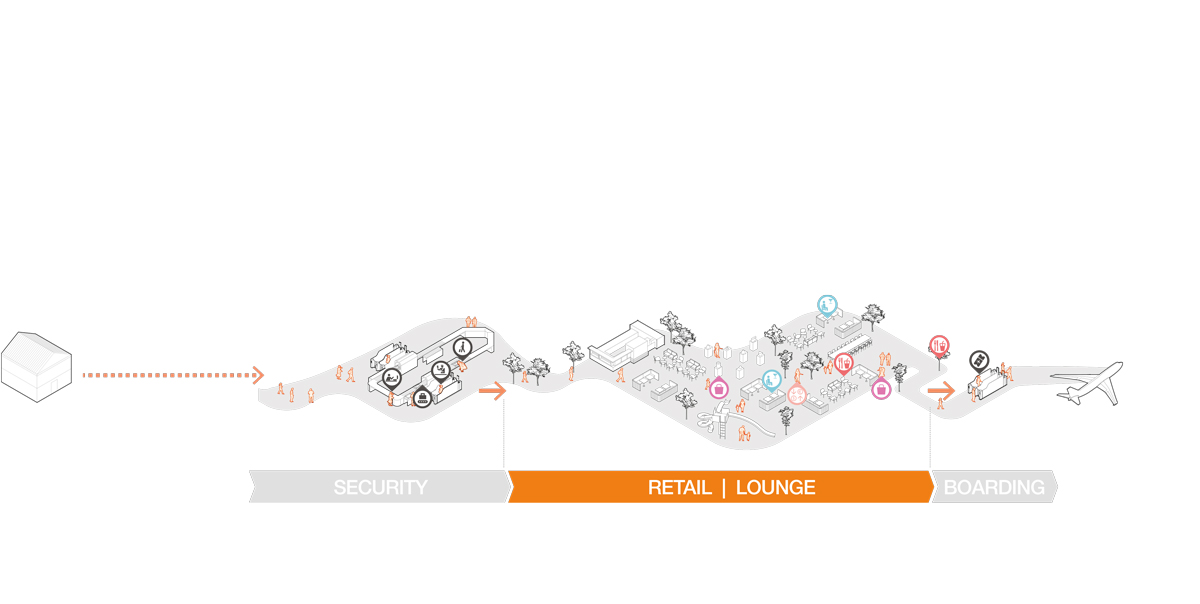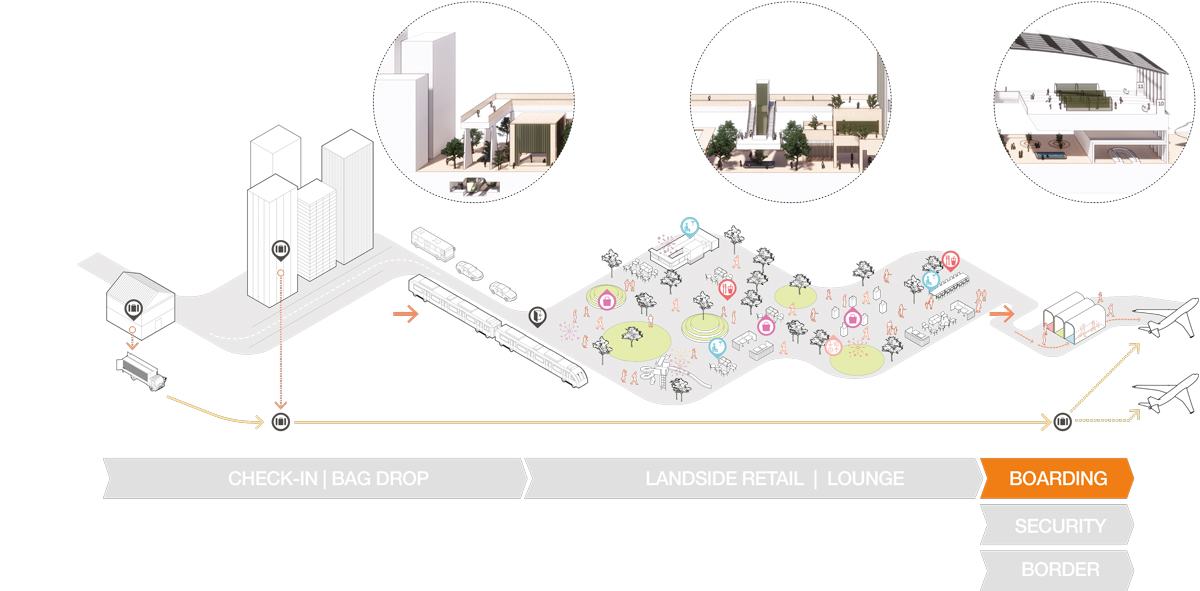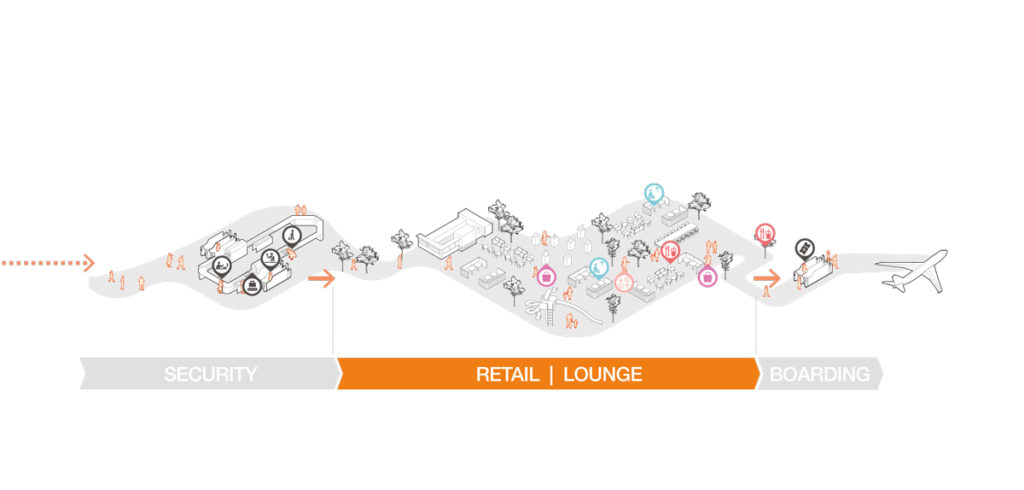Post-corona, air travel will adapt to reflect a global refocusing on safety and wellness. As a result, airports of the future will become cleaner, safer and more sustainable – while also being placed to take on the responsibility of being the first line of defense against the next global pandemic.
A plausible immediate action for airport design post-corona is a focus on becoming touch-free – eliminating unnecessary contact in order to be as safe as possible from the spread of disease. The installation of biometric contactless technology will become more commonplace and enable passengers to be processed without physical travel documentation such as passports and paper boarding passes – decreasing the chance of contamination and processing and creating a more seamless journey from arrival to take off.
This efficient contactless revolution means that we might also see a reduction in airside dwell time post-corona – with travelers feeling confident that they can reliably predict how quickly they can board their flight. Virtual queuing technology that notifies passengers when their seat is boarding and remote ‘off-airport’ baggage processing services – which collect luggage from a person’s home and deliver it straight to their accommodation – will also decrease the need to arrive early.

It’s likely that, at least in the immediate short term, many of us will feel safer avoiding being in crowded indoor spaces for prolonged periods of time due to lessons learned from the current infection risks. As a result, airports hoping to host travelers for longer may encourage dwell time outside in the open air – limiting time spent in crowded indoor conditions that can promote the spread of airborne viruses more quickly.
These outdoor spaces have the potential to be exceptional. Traditionally, airport lounges are ‘airside’ and feature an outward view of airfield activity, but open-air ‘landside’ airport lounges hold the promise of a genuine connection to country by bonding users with the landscape by placing them within it.
Done right, these open-air spaces will create meaningful associations with their unique setting – moving airports firmly away from the homogenized ‘white box’ design toward being site-specific spaces that create a unique sense of place.
Imagine an outdoor civic realm with space for dining, retail and entertainment where people – traveling or non-traveling – could mingle and relax. Lush, convenient and safe, these destinations would use native flora and sensitive references to the natural landscape to foster connection between travelers and the unique natural features of the setting.
Airport designs that work to cultivate a connection between airport users and nature would also have health benefits. Aspects of biophilic design such as greenery, high air quality and natural materials are likely to be integrated into airport design and budgets due to their proven relationship to reducing stress and enhancing human health and wellbeing – creating green, people-centric spaces.

It is predicted that, post-corona, non-essential travel will be reconsidered by consumers due to its impact on global warming. Thanks to lessons learned from social distancing measures across the globe, the need to meet in person for business has been revealed as less critical than our need to care for the planet – with many embracing the efficient and carbon-neutral benefits of video conferencing software. The projected rise in people practicing low-impact living may see air travel mindfully returning to being treated as an activity done out of necessity or for a special occasion.
Air travel may decline, but it will by no means die out. And, when people do travel, airports may actually have a very important role to play in avoiding the next pandemic. The anticipated widespread installation of contactless biometric screening will enable borders to respond dynamically and with agility to control the risk of outbreak – potentially stopping the spread entirely. In short, airports could become the first line of defense.
Because biometric technology already detects the emotional state of passengers by monitoring heart rate, temperature and facial cues, it’s feasible to imagine its reach expanding to the detection of symptomatic characteristics such as fever in a post-corona world – identifying those that are positive or exposed in order to best support them.

Similarly, the capabilities of airport parking lots and hotels could be extended – with parking lots being designed with the capability to become field hospitals and hotels easily being upgraded to include simple isolation measures for those affected. The need to design for the next pandemic may be intimating, but it’s certainly time – California has already pinpointed the ability to monitor and test for the next pandemic in its guide to lifting the state’s coronavirus restrictions.
The repercussions coronavirus has had on how we live, work and think have yet to be measured in full. However, a silver lining has already emerged – the crisis has brought us together. By bringing into sharp focus how closely we’re connected, the pandemic has made it clear that our future survival will depend on looking after everyone – including those societies with poor health systems. For air travel, this means a dramatic reassessment to ensure our airports are safe and sustainable – at last, the wellness of travelers is not just for a few but an imperative for all.

